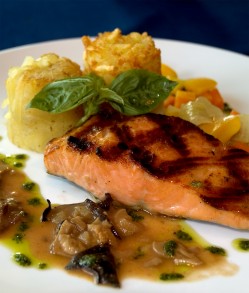Just the mention of roasted chicken makes your mouth water, but have you ever considered the versatility of a rotisserie grill for yourself?
From turkeys to roasts to chicken, a rotisserie grill makes any meal a gourmet event; you do not have to go to a fancy restaurant to enjoy a juicy, tender bite.
Rotisserie Grills: Features
Whether you go with an independent rotisserie grill system or a rotisserie kit that attaches to your present grill, there are some key features to look for. The most important feature to look at is the actual spit, the rod that passes through the meat and rests on the brackets of the turning system; most spits are 20-40 inches, but some systems come with spit extenders. You also want to make sure that the skewers or forks are durable and will not bend under the weight of the meat.
Drip trays to collect the juices and roasting baskets to cook veggies or smaller portions of meat are other convenient features to be considered. When looking at the rotisserie motor, a twin direction motor is best; this motor reverses direction throughout the cooking process to provide even more balanced heating. A fun alternative to the traditional grill rotisserie is the version that goes over a campfire; you don’t have to confine your camp-out fare to just hamburgers and hot-dogs, though those can be cooked on a rotisserie as well.
Rotisserie Grills: Pros and Cons
Everyone knows that roasting your meat is much tastier and more nutritious than frying. By turning on a spit, the meat maintains its juices, moving them over and through the meat instead of dripping them out; however, more fat is eliminated in the roasting process. And with roasting baskets, you can also cook up some delicious veggies to go with your meat. Now roasting is not a quick process, but the end result is well worth the wait; because you are cooking large pieces of meat, the whole animal in some cases, it will take longer to cook.
Rotisserie Grills: Is It For You?
If you are looking for a more healthy but tasty way to eat meat, then a rotisserie system for your grill is a great alternative. And there are so many trusted name-brands to choose from: Weber, Char-Broil, and of course George Foreman. Roasted chicken, roasted lamb, roasted beef—they are not just for the oven anymore, and they are not just for the market or restaurant. A rotisserie grill gives you the opportunity to turn out juicy, fall off the fork meat dishes worthy of the gourmet chef.
Go back to Types of Grills Main Page
Go to iGrillBBQ.com Home Page from Rotisserie Grills
